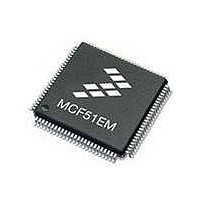MCF51EM256CLL Freescale Semiconductor, MCF51EM256CLL Datasheet - Page 315

MCF51EM256CLL
Manufacturer Part Number
MCF51EM256CLL
Description
IC MCU 32BIT 256KB FLASH 100LQFP
Manufacturer
Freescale Semiconductor
Series
MCF51EMr
Datasheets
1.MCF51EM128CLL.pdf
(2 pages)
2.MCF51EM128CLL.pdf
(54 pages)
3.MCF51EM128CLL.pdf
(636 pages)
Specifications of MCF51EM256CLL
Core Processor
Coldfire V1
Core Size
32-Bit
Speed
50MHz
Connectivity
I²C, SCI, SPI
Peripherals
LCD, LVD, PWM, WDT
Number Of I /o
63
Program Memory Size
256KB (256K x 8)
Program Memory Type
FLASH
Ram Size
16K x 8
Voltage - Supply (vcc/vdd)
1.8 V ~ 3.6 V
Data Converters
A/D 16x12b
Oscillator Type
External
Operating Temperature
-40°C ~ 85°C
Package / Case
100-LQFP
Processor Series
MCF51EM
Core
ColdFire V1
Data Bus Width
32 bit
Data Ram Size
16 KB
Interface Type
RS-232, LIN
Maximum Clock Frequency
50 MHz
Number Of Timers
3
Operating Supply Voltage
1.8 V to 3.6 V
Maximum Operating Temperature
+ 85 C
Mounting Style
SMD/SMT
3rd Party Development Tools
JLINK-CF-BDM26, EWCF
Development Tools By Supplier
DEMOEM
Minimum Operating Temperature
- 40 C
Lead Free Status / RoHS Status
Lead free / RoHS Compliant
Eeprom Size
-
Lead Free Status / Rohs Status
Lead free / RoHS Compliant
Available stocks
Company
Part Number
Manufacturer
Quantity
Price
Company:
Part Number:
MCF51EM256CLL
Manufacturer:
FREESCALE
Quantity:
110
Company:
Part Number:
MCF51EM256CLL
Manufacturer:
Freescale Semiconductor
Quantity:
10 000
- Current page: 315 of 636
- Download datasheet (11Mb)
Clearing of this interrupts depends on state of SPIxC3[3] and the status of TNEAREF as described
Section 13.3.4, “SPI Status Register
13.4.11.6 RNFULLF
RNFULLF is set when more than three16bit word or six 8bit bytes of data remain in the receive FIFO
provided SPIxC3[4] = 0 or when more than two 16bit word or four 8bit bytes of data remain in the receive
FIFO provided SPIxC3[4] = 1.
Clearing of this interrupts depends on state of SPIxC3[3] and the status of RNFULLF as described
Section 13.3.4, “SPI Status Register
13.5
13.5.1
13.5.1.1
Before the SPI module can be used for communication, an initialization procedure must be carried out, as
follows:
13.5.1.2
In this example, the SPI module will be set up for master mode with only hardware match interrupts
enabled. The SPI will run in 16-bit mode at a maximum baud rate of bus clock divided by 2. Clock phase
and polarity will be set for an active-high SPI clock where the first edge on SPSCK occurs at the start of
the first cycle of a data transfer.
Freescale Semiconductor
1. Update control register 1 (SPIxC1) to enable the SPI and to control interrupt enables. This register
2. Update control register 2 (SPIxC2) to enable additional SPI functions such as the SPI match
3. Update the baud rate register (SPIxBR) to set the prescaler and bit rate divisor for an SPI master.
4. Update the hardware match register (SPIxMH:SPIxML) with the value to be compared to the
5. In the master, read SPIxS while SPTEF = 1, and then write to the transmit data register
also sets the SPI as master or slave, determines clock phase and polarity, and configures the main
SPI options.
interrupt feature, the master mode-fault function, and bidirectional mode output. 8- or 16-bit mode
select and other optional features are controlled here as well.
receive data register for triggering an interrupt if hardware match interrupts are enabled.
(SPIxDH:SPIxDL) to begin transfer.
Initialization/Application Information
SPI Module Initialization Example
Initialization Sequence
Pseudo—Code Example
MCF51EM256 Series ColdFire Integrated Microcontroller Reference Manual, Rev. 8
(SPIxS).”
(SPIxS).”
16-Bit Serial Peripheral Interface (SPI16)
13-29
Related parts for MCF51EM256CLL
Image
Part Number
Description
Manufacturer
Datasheet
Request
R

Part Number:
Description:
BOARD DEMO HARDWARE ONLY
Manufacturer:
Freescale Semiconductor
Datasheet:

Part Number:
Description:
IC MCU 32BIT 128KB FLASH 100LQFP
Manufacturer:
Freescale Semiconductor
Datasheet:

Part Number:
Description:
IC MCU 32BIT 128KB FLASH 80LQFP
Manufacturer:
Freescale Semiconductor
Datasheet:

Part Number:
Description:
IC MCU 32BIT 256KB FLASH 80LQFP
Manufacturer:
Freescale Semiconductor
Datasheet:
Part Number:
Description:
Manufacturer:
Freescale Semiconductor, Inc
Datasheet:
Part Number:
Description:
Manufacturer:
Freescale Semiconductor, Inc
Datasheet:
Part Number:
Description:
Manufacturer:
Freescale Semiconductor, Inc
Datasheet:
Part Number:
Description:
Manufacturer:
Freescale Semiconductor, Inc
Datasheet:
Part Number:
Description:
Manufacturer:
Freescale Semiconductor, Inc
Datasheet:
Part Number:
Description:
Manufacturer:
Freescale Semiconductor, Inc
Datasheet:
Part Number:
Description:
Manufacturer:
Freescale Semiconductor, Inc
Datasheet:
Part Number:
Description:
Manufacturer:
Freescale Semiconductor, Inc
Datasheet:
Part Number:
Description:
Manufacturer:
Freescale Semiconductor, Inc
Datasheet:
Part Number:
Description:
Manufacturer:
Freescale Semiconductor, Inc
Datasheet:











